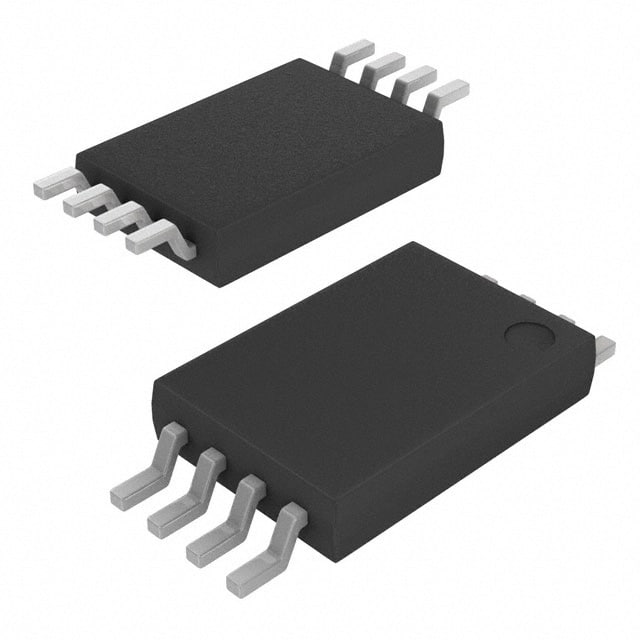S-24C32CI-T8T1U3
Basic Information Overview
- Category: Integrated Circuit (IC)
- Use: Memory storage
- Characteristics: Non-volatile, serial EEPROM
- Package: TSSOP-8
- Essence: 32K-bit I2C-compatible EEPROM
- Packaging/Quantity: Tape and reel, 3000 units per reel
Specifications
- Memory Size: 32 kilobits (4 kilobytes)
- Interface: I2C (Two-wire Serial Interface)
- Supply Voltage: 1.7V to 5.5V
- Operating Temperature Range: -40°C to +85°C
- Write Endurance: 1 million cycles
- Data Retention: 100 years
Detailed Pin Configuration
The S-24C32CI-T8T1U3 IC has the following pin configuration:
| Pin Number | Pin Name | Description | |------------|----------|-------------| | 1 | A0 | Address input bit 0 | | 2 | A1 | Address input bit 1 | | 3 | A2 | Address input bit 2 | | 4 | VSS | Ground | | 5 | SDA | Serial data input/output | | 6 | SCL | Serial clock input | | 7 | WP | Write protect input | | 8 | VCC | Power supply voltage |
Functional Features
- Non-volatile memory: The S-24C32CI-T8T1U3 retains data even when power is removed.
- I2C compatibility: It supports the widely-used I2C serial interface for easy integration into various systems.
- High write endurance: With a write endurance of 1 million cycles, it can handle frequent data updates.
- Low power consumption: The IC operates with a supply voltage as low as 1.7V, making it suitable for battery-powered devices.
Advantages and Disadvantages
Advantages: - Compact size and lightweight - Easy to interface with other I2C-compatible devices - High data retention period - Wide operating temperature range
Disadvantages: - Limited memory capacity compared to larger EEPROMs - Relatively slower write speed compared to some other memory technologies
Working Principles
The S-24C32CI-T8T1U3 is based on Electrically Erasable Programmable Read-Only Memory (EEPROM) technology. It stores data in non-volatile memory cells that can be electrically erased and reprogrammed. The IC communicates with the host system through the I2C serial interface, allowing for easy reading and writing of data.
Detailed Application Field Plans
The S-24C32CI-T8T1U3 is widely used in various applications, including but not limited to: - Consumer electronics: Used for storing configuration settings, user preferences, and small data sets in devices like TVs, set-top boxes, and audio systems. - Industrial automation: Employed in control systems, sensors, and data loggers to store calibration data, event logs, and system parameters. - Automotive electronics: Integrated into automotive modules for storing critical data such as mileage, fault codes, and vehicle settings. - Medical devices: Utilized in medical equipment for storing patient information, device configurations, and usage logs.
Detailed and Complete Alternative Models
Some alternative models to the S-24C32CI-T8T1U3 include: - AT24C32: A similar 32K-bit I2C-compatible EEPROM from Atmel. - CAT24C32: Another 32K-bit I2C-compatible EEPROM from ON Semiconductor. - M24C32: A 32K-bit I2C-compatible EEPROM from STMicroelectronics.
These alternative models offer similar functionality and can be used as replacements depending on specific requirements.
Word count: 486 words
רשום 10 שאלות ותשובות נפוצות הקשורות ליישום של S-24C32CI-T8T1U3 בפתרונות טכניים
Sure! Here are 10 common questions and answers related to the application of S-24C32CI-T8T1U3 in technical solutions:
Q1: What is S-24C32CI-T8T1U3? A1: S-24C32CI-T8T1U3 is a specific model of an I2C-compatible EEPROM (Electrically Erasable Programmable Read-Only Memory) chip.
Q2: What is the storage capacity of S-24C32CI-T8T1U3? A2: The S-24C32CI-T8T1U3 has a storage capacity of 32 kilobits, which is equivalent to 4 kilobytes.
Q3: What is the operating voltage range for S-24C32CI-T8T1U3? A3: The operating voltage range for S-24C32CI-T8T1U3 is typically between 1.7V and 5.5V.
Q4: How does S-24C32CI-T8T1U3 connect to a microcontroller or other devices? A4: S-24C32CI-T8T1U3 uses the I2C communication protocol and requires two lines - SDA (Serial Data) and SCL (Serial Clock) - to connect to a microcontroller or other devices.
Q5: Can S-24C32CI-T8T1U3 be used for storing user data in embedded systems? A5: Yes, S-24C32CI-T8T1U3 can be used to store user data in embedded systems, such as configuration settings, calibration data, or small amounts of non-volatile memory.
Q6: What is the maximum clock frequency supported by S-24C32CI-T8T1U3? A6: The maximum clock frequency supported by S-24C32CI-T8T1U3 is 400 kHz.
Q7: Does S-24C32CI-T8T1U3 have built-in write protection features? A7: Yes, S-24C32CI-T8T1U3 supports software write protection of individual memory blocks or the entire chip.
Q8: Can S-24C32CI-T8T1U3 operate in extreme temperature conditions? A8: Yes, S-24C32CI-T8T1U3 has an extended temperature range and can operate in temperatures ranging from -40°C to +85°C.
Q9: Is S-24C32CI-T8T1U3 compatible with different microcontroller platforms? A9: Yes, S-24C32CI-T8T1U3 is compatible with various microcontroller platforms that support the I2C communication protocol.
Q10: Are there any specific programming requirements for S-24C32CI-T8T1U3? A10: S-24C32CI-T8T1U3 can be programmed using standard I2C commands, and the datasheet provides detailed information on the programming process.
Please note that these answers are general and may vary depending on the specific implementation and requirements of your technical solution.


